Did you know that on average, homeowners spend $3,000-$5,000 annually on pool maintenance and repairs?
Keeping a pool clean and well-maintained is essential for an enjoyable and safe swimming experience. However, the costs of pool maintenance can quickly add up, impacting your budget.
In this article, we will explore key factors that significantly affect pool maintenance costs and provide valuable tips to help you reduce these expenses without compromising the quality of your pool.
From proper chemical balance and efficient filtration to energy-saving strategies and smart DIY maintenance, we will show you how to keep your gunite pool in top shape while keeping costs in check.
By implementing these cost-saving measures, you can make pool ownership a more affordable and rewarding experience. Let’s dive in!
Table of Contents
- 1 Key Takeaways
- 2 How Much Does it Cost to Maintain a Gunite Pool
- 3 How to Maintain a Gunite Pool
- 4 Key Factors That Influence Pool Maintenance Costs
- 5 Tips to Reduce Gunite Pool Maintenance Costs
- 6 Conclusion
- 7 Frequently Asked Questions
- 7.1 1. Are there any hidden expenses associated with maintaining a gunite pool?
- 7.2 2. How do the maintenance costs of a gunite pool compare to other types of pools?
- 7.3 3. Can I save money on pool maintenance by doing some tasks myself?
- 7.4 4. How does the size and shape of my gunite pool impact maintenance expenses?
- 7.5 5. What water-saving measures can I implement to reduce maintenance costs?
- 7.6 6. How do seasonal changes affect pool maintenance expenses?
Key Takeaways
- The average yearly cost of pool maintenance for a gunite pool is approximately $960 to $1,800.
- Total pool upkeep, including minor repairs, electricity, and water, can range from $3,000 to $6,000 per year for gunite pools.
- Weekly pool maintenance typically costs around $20 to $50 per week, depending on the workload.
- DIY maintenance can save you approximately $1,200 per year with the initial equipment costs of around $50 for essential items.
- Key factors influencing pool maintenance costs include pool size, type, pool material, sanitization system, indoor vs. outdoor pool, and geographic location.
- In-ground gunite pools are more expensive to maintain compared to above-ground pools, with vinyl and fiberglass pools having lower maintenance costs.
- Saltwater pools can reduce chemical usage but may have higher repair costs over time.
- Indoor pools have lower maintenance costs due to reduced exposure to outdoor elements and lower water evaporation.
- Pool maintenance costs are higher in warm climates with longer pool seasons and can vary based on local labor rates.
- Regular maintenance tasks include testing water chemicals, adding chlorine, skimming, running the pool’s pump, and checking equipment for leaks or malfunctions.
- Weekly maintenance includes vacuuming, brushing surfaces, emptying pump/skimmer baskets, backwashing filters, and adding chemical shock treatments.
- Major maintenance tasks like seasonal opening and closing, draining, acid washing, refilling the pool, resurfacing, tile replacement, pump and filter maintenance, heater maintenance, and coping and deck repairs also influence overall maintenance costs.
How Much Does it Cost to Maintain a Gunite Pool
The cost of maintaining a gunite pool can vary based on several factors, as mentioned in the provided information. Here’s a breakdown of the average costs involved:
- Yearly Pool Maintenance: The average yearly cost of pool maintenance for a gunite pool is approximately $960 to $1,800. This cost covers regular upkeep and maintenance tasks to keep the pool clean and functioning properly.
- Total Pool Upkeep: This includes the yearly maintenance cost along with additional expenses such as minor repairs, electricity, and water. For gunite pools, the total pool upkeep costs can range from $3,000 to $6,000 per year.
- Weekly Pool Maintenance: For weekly pool maintenance, the cost is typically around $20 to $50 per week. The exact price depends on the amount of work needed to be done each week to ensure the pool remains in good condition.
- Pool Opening and Closing: When considering more expensive weekly service contracts, the cost to open and close the pool each year (at the beginning and end of the swimming season) is around $300 to $650, and this cost should be included in the contract.
- DIY Maintenance: Doing the pool maintenance yourself can save you approximately $1,200 per year. The initial costs for essential equipment like a year-round pool vacuum and hose are about $50, while fall maintenance kits may cost around $60. Additionally, monthly chemical maintenance kits can be purchased for $20 to $100 per month.
Overall, the cost of maintaining a gunite pool can be influenced by the pool’s size, the type of maintenance service (professional or DIY), and the frequency of maintenance. It’s essential to consider these factors when budgeting for the annual pool maintenance expenses. We’ll discuss each of the factors in detail below.
How to Maintain a Gunite Pool
Maintaining a gunite pool requires regular care and attention to keep it clean, safe, and in good condition. Here are some essential steps to help you maintain your gunite pool:
- Skim and Brush Regularly: Use a skimmer net to remove leaves, insects, and debris from the pool’s surface daily. Additionally, brush the walls and floor of the pool weekly to prevent algae and scale buildup.
- Monitor Water Level: Keep an eye on the water level and make sure it stays at the appropriate level, usually about halfway up the skimmer opening. If it drops too low, use a hose to refill it.
- Maintain Proper Water Chemistry: Regularly test the water chemistry using a pool water testing kit. The key parameters to monitor are pH, chlorine levels, alkalinity, and calcium hardness. Maintain the following ranges and adjust the chemicals as needed to keep the water balanced and avoid problems like algae growth, scaling, and equipment damage.
- pH: 7.4 – 7.6
- Free Chlorine: 2 – 4 ppm
- Total Alkalinity: 80 – 120 ppm
- Calcium Hardness: 200 – 400 ppm
- Shock the Pool: Regularly shock the pool to eliminate bacteria, algae, and other contaminants. Follow the manufacturer’s guidelines for the appropriate shock treatment for your pool size.
- Clean the Filter: The pool’s filter helps to remove impurities from the water. Depending on the type of filter (sand, cartridge, or DE), you’ll need to clean or backwash it periodically. Follow the manufacturer’s instructions for the specific filter type.
- Inspect and Maintain Pool Equipment: Check the pool equipment such as pumps, skimmers, and heaters regularly for any signs of damage or malfunction. Clean out skimmer baskets and pump strainers to prevent clogging.
- Vacuum and Clean the Pool: Use a pool vacuum to clean the pool floor and remove any dirt or debris that has settled. You can also use a pool brush and automatic pool cleaner for routine cleaning. For additional tips on how to clean a gunite pool effectively, check out our how to clean a gunite pool article
- Winterize the Pool (if applicable): If you live in a region with cold winters, you’ll need to winterize the pool properly. This involves lowering the water level, cleaning the pool thoroughly, and protecting it from freezing temperatures. Follow the specific winterization process for gunite pools.
- Regular Maintenance: Apart from the above tasks, it’s crucial to have a regular maintenance schedule that includes cleaning the pool deck, inspecting the pool perimeter, checking for leaks, and ensuring safety equipment (e.g., life rings, first aid kits) is in place. For more detailed information on maintaining a gunite pool, you can refer to our how do you maintain a gunite pool article.
- Professional Inspections: Schedule periodic professional inspections and servicing of the pool to catch any issues early and ensure proper functioning.
Key Factors That Influence Pool Maintenance Costs
Maintaining a pool is a crucial aspect of ensuring it remains in top condition for years of enjoyment. However, pool maintenance costs can vary depending on several key factors. Factors such as pool size and type, pool material, sanitization system, indoor vs. outdoor pool, geographic location, and the extent of maintenance tasks can all influence the overall maintenance expenses.
Understanding these key factors will help you make informed decisions to keep your pool in excellent shape while managing costs effectively. Let’s dive deeper into each of these factors to explore how they impact pool maintenance costs.
1. Pool Size and Type
When it comes to maintaining a gunite pool, understanding the pool size and type is crucial as they greatly influence the overall maintenance costs. Larger pools generally require more resources such as chemicals and cleaning time, leading to higher expenses.
Additionally, the type of pool, whether it’s an in-ground or above-ground pool, also affects the maintenance costs. Let’s explore how these factors impact the cost breakdown of maintaining a gunite pool.
| Category | Range of Maintenance Cost |
|---|---|
| Pool Size | |
| Small (under 15,000 gallons) | $80 – $150 per month |
| Medium (15,000 – 30,000 gallons) | $150 – $250 per month |
| Large (over 30,000+ gallons) | $250 – $400+ per month |
| In Ground Vs Above Ground Pool | |
| In Ground Pool | $200 – $400 per month |
| Above Ground Pool | $100 – $200 per month |
| Pool Material | |
| Gunite | $450 – $1,200 per year |
| Fiberglass | $300 – $550 per year |
| Vinyl Liner | $350 – $800 per year |
| Tile and Plaster | $500 – $1,000 per year |
| Chlorine Vs Saltwater | |
| Chlorine Pool | $50 – $100 per hour |
| Saltwater Pool | $80 – $100 per month |
| Indoor Vs Outdoor | |
| Indoor Pool | $25 – $50 per hour |
| Outdoor Pool | $60 – $100 per hour |
Pool Size
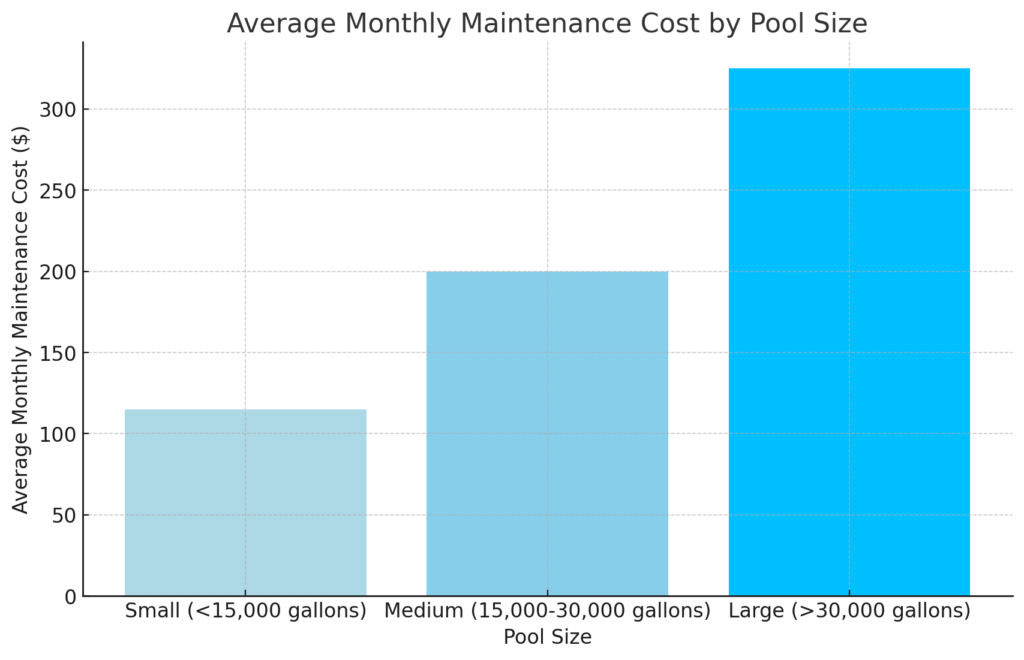
The size of your swimming pool is a major factor in determining ongoing maintenance costs. Larger pools require more chemicals, electricity, cleaning time, and regular upkeep which leads to higher costs. For reference:
- Small pools under 15,000 gallons have monthly maintenance costs in the range of $80-$150. The smaller water volume requires fewer chemicals and less cleaning time compared to larger counterparts.
- Medium sized pools from 15,000 to 30,000 gallons have monthly maintenance costs from $150-$250 typically. This mid-range size is common for residential inground pools. More water equates to more chemicals and cleaning time.
- Large pools over 30,000+ gallons can cost $250-$400+ per month for maintenance. Oversized residential pools and public/community pools fall into this category. The expansive water surface area takes more time, effort, and chemicals to keep sparkling clean.
When planning for a new pool installation, carefully consider the desired size. While a larger pool may be more impressive, it will continually cost more over time for regular maintenance compared to a smaller or more moderately sized pool for residential needs. Carefully weigh the upfront costs of construction with the ongoing expenses for maintenance based on pool gallons.
In Ground Vs Above Ground Pool
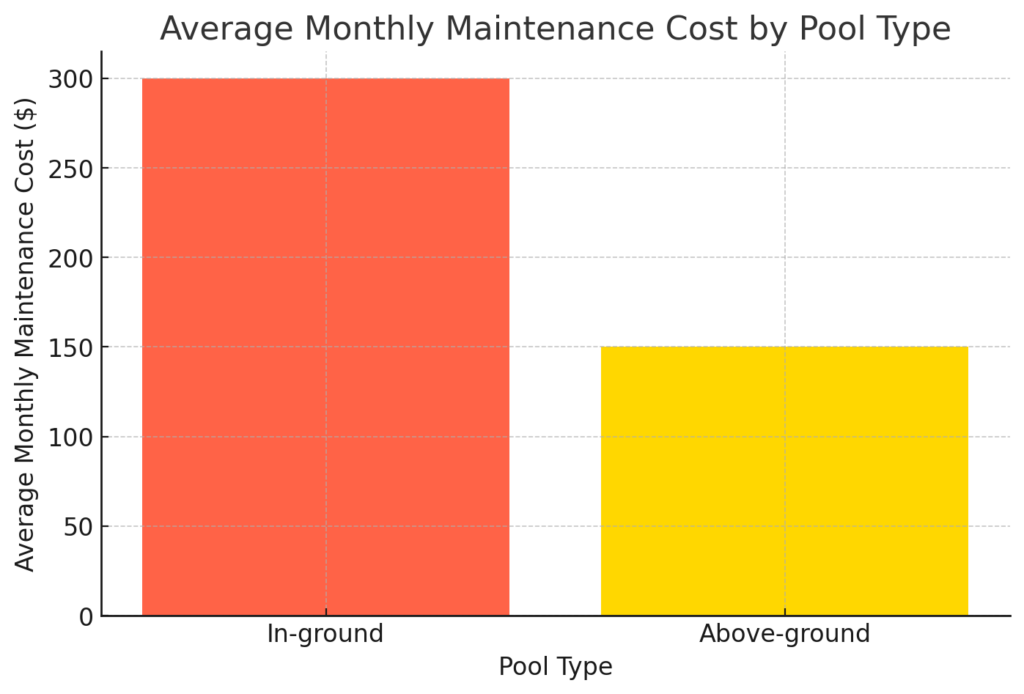
In ground and above ground pools have different maintenance needs and expenses.
In ground pools are more costly to maintain due to their larger size, excavated structure, and use of gunite, tile, or plaster surfaces. The typical maintenance cost for an in ground pool ranges from $200-$400 per month.
Their installed structure makes in ground pools harder to access and clean thoroughly. The gunite or tile finishes also offer more surface area for algae and mineral buildup to form, increasing cleaning labor.
Above ground pools are simpler and more affordable for regular maintenance, averaging $100-$200 per month. Their above-surface construction makes the pool walls and floors more accessible for cleaning.
Materials like vinyl, fiberglass, or steel panels also have less risk of staining, scaling, or algae growth compared to plaster or tile. However, above ground pools still require pumping equipment, chemicals, cleaning tools, and labor to keep water sanitary.
While inground pools have a premium look and feel, their maintenance is undoubtedly more complex and costly long-term. Above ground pools offer a more budget-friendly option both upfront and for ongoing upkeep. Assess your budget and how involved you want to be in regular maintenance when choosing between in ground and above ground pools.
Pool Material
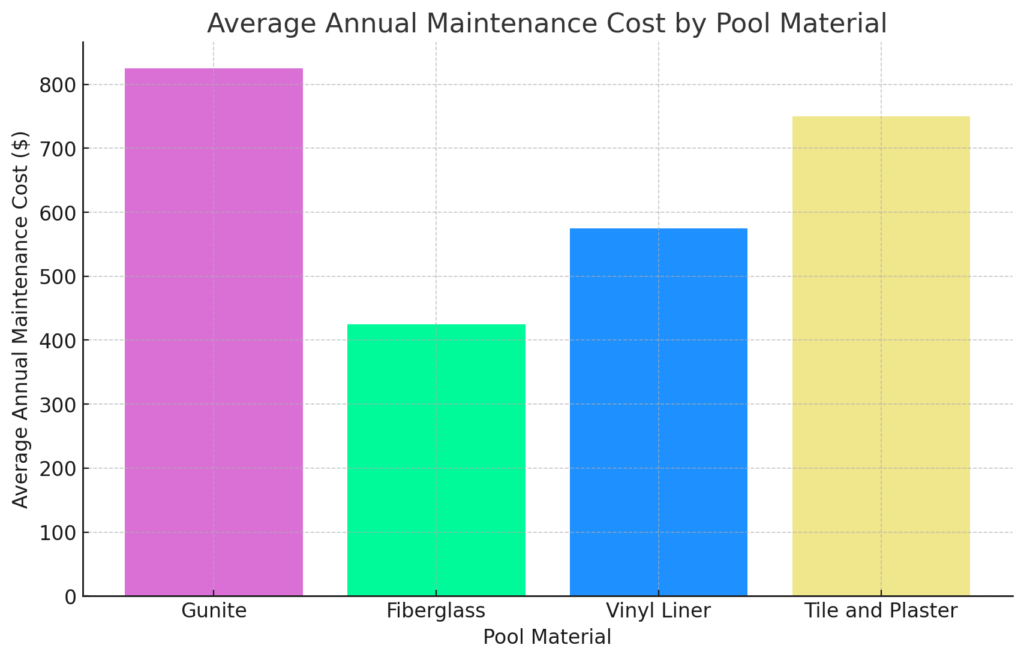
The most common pool materials are gunite, plaster, tile, vinyl, and fiberglass. The surface material affects both regular maintenance and longevity between resurfacings.
- Gunite pools have the highest maintenance costs, averaging $450-$1,200 yearly. The porous gunite surface is prone to algae growth, staining, and scaling which increases cleaning labor and chemical costs.
- Fiberglass pools are the most affordable to maintain long-term at $300-$550 per year. The non-porous fiberglass surface resists staining and debris buildup. Minimal chemical cleaning is required.
- Vinyl liner pools fall in the middle price range at $350-$800 annually. Vinyl is also non-porous but more prone to tearing over gunite or fiberglass. Liner replacement is needed periodically.
- Tile and plaster pools have similar maintenance needs and expenses as gunite. The textured surfaces require vigilant cleaning and chemical care to stay pristine. Costs range from $500-$1,000.
When choosing a pool material, assess the ongoing costs for chemicals, cleaning and potential resurfacing or repairs. While gunite is popular, more affordable options like vinyl and fiberglass have better long-term maintenance value.
Chlorine Vs Saltwater

Chlorine pools use chlorine-based chemicals to sanitize the water. Maintenance costs typically run $50-$100 per hour and focus on monitoring and adjusting chlorine levels regularly. A chlorine pool requires the purchase of chlorine additives on an ongoing basis.
Saltwater pools convert dissolved salt into chlorine through an electrolytic generator. The equipment costs more upfront but can reduce chemical usage over time. Average monthly maintenance fees for saltwater pools range from $80-$100. The salt cell needs periodic replacement every 3-7 years at around $800.
While saltwater systems aim to reduce chlorine costs, the salt can damage pools surfaces and equipment at a faster rate if calcium and pH aren’t properly balanced. This can increase repair costs for saltwater pools over time. The salt cell may also need more frequent replacements in certain water conditions.
When choosing a sanitization system, weigh the pros and cons for long-term costs. Chlorine offers affordable upfront costs but requires frequent chemical replenishment. Saltwater carries a higher initial investment but may save on chemicals when maintained properly. Consider your maintenance schedule and abilities when deciding between these two popular options.
Indoor Vs Outdoor
Indoor pools are significantly cheaper to maintain than outdoor pools. Indoor pool maintenance costs range from $25-$50 per hour on average. Whereas outdoor pool maintenance typically runs $60-$100 per hour.
Several factors make indoor pool upkeep more affordable. These factors include:
- Reduced Exposure to Outdoor Elements: Indoor pools are sheltered from outdoor elements like weather, debris, and sunlight. This reduces the need for chemical usage and frequent cleaning, resulting in cost savings.
- Lower Water Evaporation: Indoor pools experience less water evaporation compared to outdoor pools exposed to direct sunlight and wind. As a result, indoor pools require less frequent water replacement, leading to reduced water and chemical costs.
- Lower Temperature Control Costs: Indoor pools benefit from the controlled indoor environment, which reduces the need for extreme temperature adjustments. This results in lower energy costs associated with maintaining the pool water at the desired temperature.
- Reduced Risk of Algae Growth: Algae growth in pools is often triggered by exposure to natural light. Since indoor pools are not exposed to direct sunlight, the risk of algae growth is significantly reduced, lowering the need for chemical treatment and cleaning.
- Low Humidity Levels: Indoor pool areas are designed to manage humidity levels effectively. Excess humidity can lead to condensation and water-related damage. By controlling humidity, indoor pools avoid potential maintenance issues related to moisture.
- No Seasonal Opening/Closing: Outdoor pools typically require seasonal opening and closing procedures to prepare for and protect them during winter. Indoor pools, being protected from outdoor conditions, do not require these additional maintenance steps, resulting in cost savings.
- Year-round Use: Many indoor pools are operational throughout the year, providing constant use and enjoyment. In contrast, outdoor pools in colder climates have limited seasonal usage, which can lead to higher per-use maintenance costs.
- Reduced Chemical Usage: Due to the controlled environment, indoor pools may require fewer chemicals to maintain water quality compared to outdoor pools exposed to environmental fluctuations.
- Reduced Cleaning Time: The reduced debris and dirt accumulation in indoor pools result in less frequent and less extensive cleaning efforts, saving both time and resources.
While indoor pools require an added investment upfront to enclose and integrate into your home, their long-term maintenance costs are noticeably lower. For homeowners looking to maximize the value of their investment, an indoor pool offers significantly more affordable upkeep over an outdoor pool.
2. Geographic Location
The geographic location plays a significant role in determining the total maintenance costs of a gunite pool. The length of the pool season directly affects the annual expenses, with warmer climates having longer pool seasons and thus higher maintenance costs.
For instance, in southern states like Arizona, Texas, and Florida, where pools can be open for 9-12 months a year, the maintenance expenses are higher compared to cooler regions with shorter pool seasons.
Additionally, local labor rates for pool technicians can vary, impacting the overall pricing for maintenance services. Understanding how your geographic location influences these costs is essential for effectively budgeting and planning for your pool’s upkeep.
Let’s explore in detail how the length of the pool season and local labor rates impact the maintenance expenses of a gunite pool.
| Category | Range of Maintenance Cost |
|---|---|
| Length of Pool Season | |
| Warm Climates | $2,000 – $4,000 per year |
| Cold Climates | $1,000 – $2,000 per year |
| Local Labor Rates | |
| Major Metro Areas | $90 – $150+ |
| Suburbs and Smaller Cities | $60 – $90 |
| Rural Locations | $50 – $75 |
Length of Pool Season
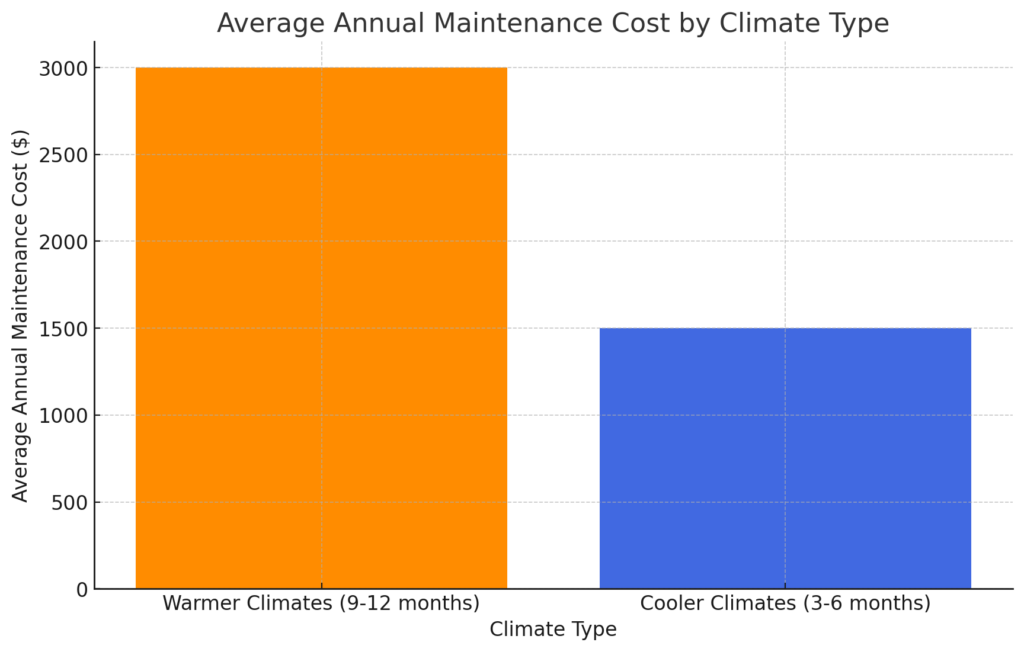
The length of your pool season directly affects total maintenance costs each year. In warm climates with year-round swimming weather, costs will be higher than cooler regions with a shorter season.
- In southern states like Arizona, Texas, and Florida, pools can be open 9-12 months out of the year. With nearly year-round use, maintenance tasks are required more frequently, increasing costs. Annual maintenance for these regions averages $2,000-$4,000.
- Northern states see more limited pool seasons around 3-6 months. With fewer months of use, maintenance tasks are less frequent and ongoing costs are lower. Annual averages range from $1,000-$2,000.
- Closing the pool for colder seasons also reduces expenses for a portion of the year. Opening and closing services still apply.
Before installing a pool, estimate the realistic number of months it can be used in your climate. Warmer locations allow more use but result in higher long-term maintenance expenses. Cooler regions have a shorter enjoyment window but with lower annual costs. Weigh your preferred season length against the resulting maintenance costs.
Local Labor Rates
The hourly rate charged by pool service technicians in your area is a key factor affecting regular maintenance expenses. Labor rates can vary significantly across different parts of the country.
- In major metro areas like Los Angeles, New York City, and Chicago, pool service techs may charge $90-$150+ per hour with higher demand and living costs.
- In suburbs and smaller cities, average rates tend to range from $60-$90 per hour with lower demand and wages.
- Rural locations often have lower hourly rates in the $50-$75 range with minimal competition among service providers.
When estimating your potential maintenance costs, look up average pool service tech rates in your local city or region. While tasks and time requirements stay relatively similar across locations, labor pricing shows wider variation. Be sure to factor in your geographic area’s competitive labor rates when planning your pool budget and assessing quotes.
While it may be tempting to simply choose the lowest hourly rate, also consider experience, training, and certifications. Paying slightly more for qualified technicians can pay off through more efficient service and the ability to spot potential problems early. Weigh both rates and qualifications when hiring.
3. Maintenance Tasks
Maintaining a gunite pool involves a combination of daily and weekly tasks that are essential for its overall upkeep and longevity. These maintenance tasks directly impact the pool’s cleanliness, water quality, and overall performance.
Daily tasks include testing water chemicals like chlorine, pH, and alkalinity using test strips, while weekly tasks involve skimming, vacuuming, and cleaning the pool’s filter system.
Additionally, periodic major maintenance, such as seasonal opening and closing, draining, and acid washing, is necessary for top-to-bottom care of the pool.
By understanding and diligently performing these maintenance tasks, pool owners can ensure their gunite pool remains in excellent condition and provides a safe and enjoyable swimming experience for years to come.
Let’s explore each of these maintenance tasks in detail to better comprehend their significance in keeping a gunite pool well-maintained.
| Category | Estimated Cost | Frequency |
|---|---|---|
| Testing water chemicals | $2 – $5 per month | Daily |
| Adding chlorine/balancing chemicals | $10 – $30 per month | Daily |
| Skimming surface debris | No direct cost | Daily |
| Running pool’s pump and filter system | $1 – $2 per day | Daily |
| Checking equipment for leaks/malfunctions | No direct cost | Daily |
| Thoroughly vacuuming and brushing surfaces | $80 – $150 per month | Weekly |
| Emptying pump/skimmer baskets | No direct cost | Weekly |
| Backwashing filters if needed | Cost of backwash water | Weekly |
| Adding chemical shock treatments | $10 – $15 per month | Weekly |
| Professional Cleaning Service | ||
| Monthly service | $100 – $260 per month | 1-4 visits/month |
| Biweekly service | $200 – $500 per month | 8-16 visits/month |
| Weekly service | $80 – $160 per month | Weekly |
| Individual cleaning | $100 – $250 per visit | 2-4 times a year |
| Major Maintenance | ||
| Seasonal Opening | $200 – $400 | Spring (Reopening) |
| Seasonal Closing | $200 – $400 | Fall |
| Draining | $150 – $250 | As needed |
| Acid Washing | $350 – $550 | Every 3-5 years |
| Refilling the Pool | $300 – $600 | After Acid Washing |
| Resurfacing/Replastering | $4,000 – $8,000 | Every 8-12 years |
| Tile Replacement | $1,500 – $3,000 | As needed |
| Pump and Filter Maintenance | $200 – $500 | Regular maintenance needed |
| Heater Maintenance | $150 – $350 | As needed |
| Coping and Deck Repairs | $1,500 – $4,000 | As needed |
Daily / Weekly Tasks
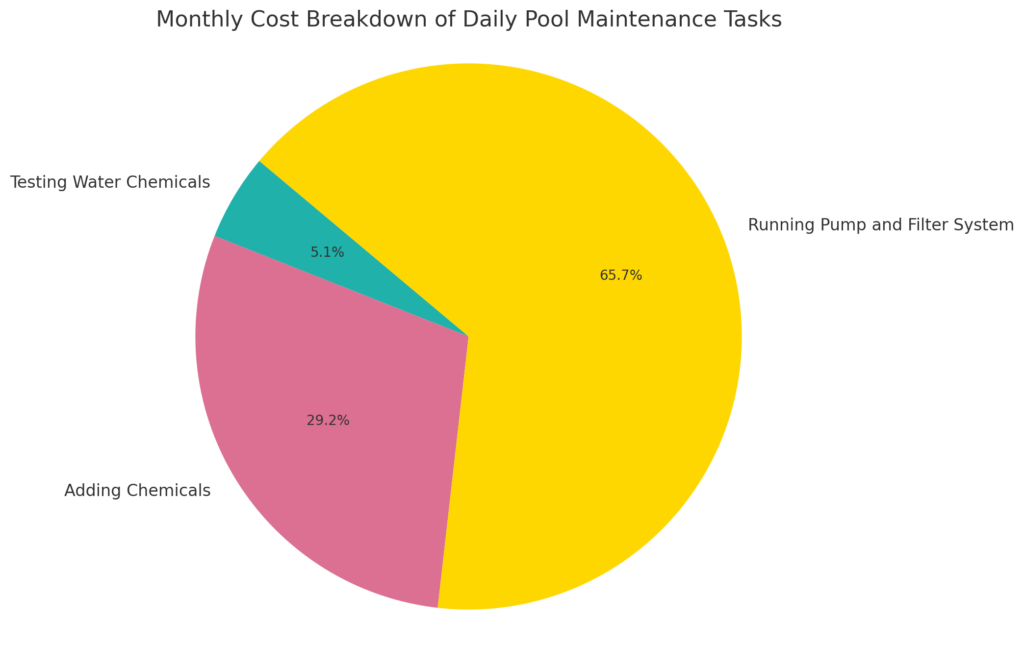
Regular pool maintenance should consist of both daily and weekly tasks, as they play a significant role in determining the overall maintenance costs. Daily tasks are essential for preserving water sanitation and quality in the time between more comprehensive weekly cleanings. These daily maintenance activities include:
- The process of testing water chemicals, including chlorine, pH, and alkalinity, involves using test strips, which typically costs $2-$5 per month for the test strips.
- To maintain water quality, adding chlorine or balancing chemicals based on test readings is necessary, with a monthly cost ranging from $10 to $30 for the chemicals.
- Removing surface debris such as insects, leaves, or other objects through skimming has no direct cost but significantly saves time and effort on future cleaning tasks.
- Running the pool’s pump and filter system incurs an electricity cost of $1-$2 per day, which can vary depending on the pump size and runtimes.
- To avoid costly repairs, it’s essential to check equipment like pumps for any leaks or malfunctions, and while this doesn’t have a direct cost, it helps prevent potential expenses down the line.
Daily maintenance for a standard 20,000-gallon pool typically requires 30 to 60 minutes, and this regular upkeep can prevent more expensive issues in the long run.
Apart from daily maintenance, pools also require weekly tasks, including:
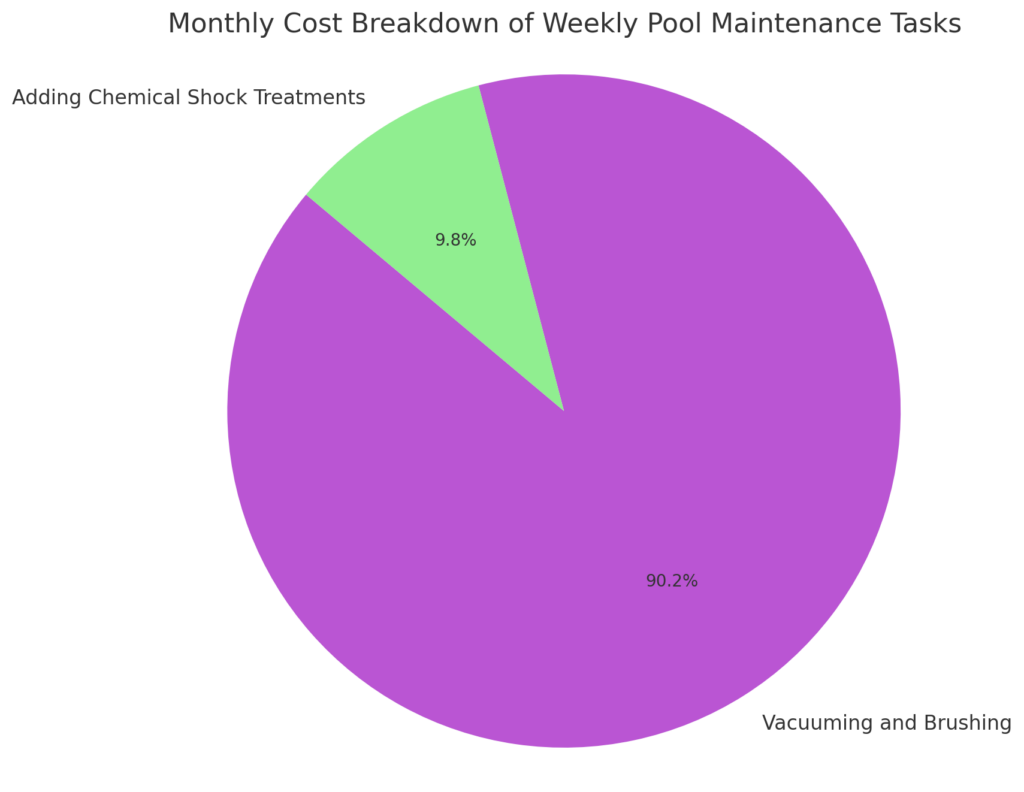
- Thoroughly vacuuming and brushing all pool surfaces, which may cost between $80 and $150 per month if hiring a professional service.
- Emptying pump/skimmer baskets, a task that takes approximately 5-10 minutes each week.
- Backwashing filters if needed, which incurs a cost for backwash water and takes approximately 15-20 minutes to complete.
- Adding chemical shock treatments to restore sanitizer levels, which may require an expense of $10 to $15 per month for shock chemicals.
Weekly maintenance may take 2-3 hours for a typical residential pool. Some tasks like scrubbing surfaces may be needed more often depending on bather load.
Professional Cleaning Service
Many pool owners opt to hire professional cleaning services to handle some or all of their regular maintenance. Here are typical costs for professional pool service:
- The monthly service costs range from $100 to $260 per month, typically encompassing 1-4 visits. This service includes standard cleaning, testing of chemicals, equipment checks, and minor surface scrubbing.
- Bi-weekly service is available at a cost of $200 to $500 per month, providing 8-16 visits. This comprehensive package covers all basic maintenance tasks and includes thorough bi-weekly cleanings.
- For weekly service, pool owners can expect to pay $80 to $160 per month. This option is ideal for frequently used pools and includes weekly vacuuming, surface brushing, skimming, and chemical testing.
- For those seeking periodic deep cleanings 2-4 times a year, individual cleaning services are available at a cost of $100 to $250 per visit.
When hiring a pro, choose a qualified local company and certified techs. Compare rates and service packages. Cleanings often cost $75-$150 per hour. Services maximize convenience but increase pool maintenance costs compared to DIY. Weigh the tradeoffs for your needs and budget.
Major Maintenance
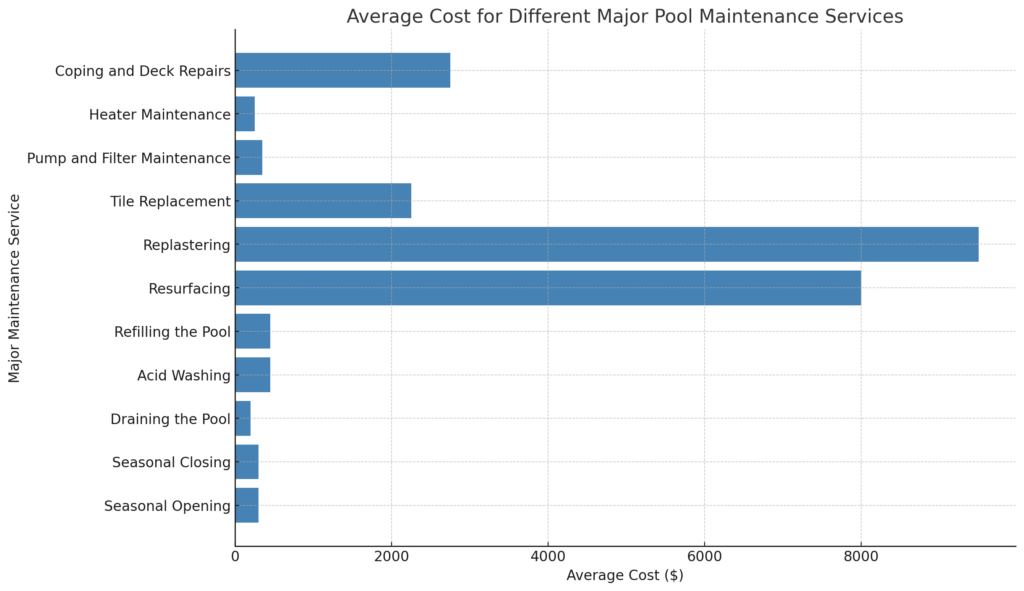
In addition to routine cleaning, pools require occasional major maintenance services for top-to-bottom care. Two common major maintenance needs are:
Seasonal Opening and Closing
- Opening in spring costs $200-$400 on average when reopening a covered pool. Tasks include uncovered the pool, rebalancing chemicals, cleaning surfaces, restarting equipment, and refilling to proper water levels.
- Closing in fall costs $200-$400 typically. The pool is drained partially, cleaned fully, equipment winterized, and a cover installed to protect the pool in cold weather seasons.
Many pool owners hire professionals for seasonal openings and closings which require time and expertise. But DIY kits are also available with instructions and chemicals.
Draining and Acid Washing
- Every 3-5 years, it may be necessary to perform a full pool drain and acid wash to eliminate stubborn stains, oils, scale, and debris that regular maintenance cannot effectively address.
- The process of draining the pool costs $150-$250, involving a complete removal of water and clearing out debris.
- For the acid washing procedure, the cost ranges from $350-$550. During this process, a muriatic acid solution is used to wash the pool surfaces, effectively dissolving the accumulated buildup. For a more detailed breakdown, read our how much does pool acid washing cost article.
- After completing the acid wash, refilling the pool typically costs $300-$600. Fresh water is trucked in to replenish the pool once the acid washing is done.
Acid washing is an intensive 1-2 day process requiring protective gear and training. Hiring a qualified professional service is highly recommended.
Other Maintenance Projects
- Resurfacing: Resurfacing a pool involves applying a new finish or coating to the existing pool shell to repair minor imperfections, improve aesthetics, and enhance durability. It is typically done when the current pool surface has signs of wear and tear, such as small cracks, chipping, or fading. Most pools require resurfacing every 8-20 years, depending on the original quality of plaster and how well the pool is maintained. Budgeting $6,000 to $10,000 for a medium sized residential pool (500 to 1000 sq ft) resurfacing is common. For a more comprehensive guide, read our how much does it cost to resurface a gunite pool guide.
- Replastering: Replastering a pool is a more extensive process that involves removing the existing plaster layer entirely and applying a new plaster coating to the pool shell. It is typically done when the current plaster has significant damage, such as deep cracks, etching, or delamination. Most pools need replastering every 10-20 years. Proper maintenance can extend the lifespan. Budgeting $7,000 to $12,000 for replastering a medium residential sized pool (500 to 1,000 sq ft) is common. Regional rates vary so get multiple quotes. For a more comprehensive guide, read our how much does it cost to replaster a gunite pool guide.
- Tile Replacement: The cost of replacing tiles in a pool varies from $1,500 to $3,000. The expense depends on the extent of tile damage and how many tiles need replacement. For a more comprehensive guide, read our how much does it cost to tile a pool guide.
- Pump and Filter Maintenance: Pump and filter maintenance typically costs between $200 and $500. This includes replacing seals, impellers, and other components as part of regular maintenance.
- Heater Maintenance: For heater maintenance, the cost ranges from $150 to $350. This maintenance involves cleaning and calibrating gas or heat pump pool heaters.
- Coping and Deck Repairs: The cost of coping and deck repairs for a pool ranges from $1,500 to $4,000. This repair process addresses issues such as cracked or shifted gunite around the pool.
The frequency and costs of major maintenance depend on factors such as pool size, materials used, and the prevailing conditions. It is advisable to anticipate spending a few thousand dollars on major maintenance every 5 to 10 years.
Additionally, it is prudent to allocate an annual budget of $1,000 to $3,000 for occasional major costs. For more significant maintenance needs, a budget of $5,000 to $10,000 every 5 to 10 years should be planned accordingly.
4. Repairs and Upgrades
Ensuring the long-term functionality and beauty of a gunite pool requires occasional repairs and strategic upgrades. Common repairs may include fixing pool pumps/motors, repairing pool surfaces like plaster or gunite, and addressing leaks or plumbing issues. The cost of repairs can vary depending on the extent of the problem and the equipment involved.
On the other hand, investing in equipment upgrades, such as energy-efficient pool pumps or advanced filtration systems, can lead to significant savings in long-term maintenance costs.
By staying proactive and addressing repairs promptly, pool owners can protect their investment and enjoy a safe and enjoyable swimming experience.
Let’s delve into the details of common repairs and potential upgrades to help you make informed decisions about maintaining your gunite pool.
| Category | Repair Cost Range | Replacement Cost Range |
|---|---|---|
| Common Repairs | ||
| Pump/motor | $50 – $300 | $250 – $650 |
| Pool heater | $100 – $400 | $1,000 – $3,500 |
| Plumbing leaks | $100 – $250 | $2,000 – $4,000 |
| Pool liner | $50 – $200 | $400 – $800 |
| Pool filter | Cartridge: $100 – $700 | Cartridge: $350 – $1,600 |
| Sand/DE: $350 – $1,600 | Sand/DE: $350 – $1,600 | |
| Underwater lights | $65 – $150 | $200 – $600 |
| Pool cover | $50 – $200 | $400 – $2,500 |
| Equipment Upgrades | ||
| Pump | $400 – $1,000 | Varies based on model/installation |
| Filter | $200 – $800 | Varies based on model/installation |
| Heater | Starts at $800 | Varies based on model/installation |
| Cleaning system | Starts at $1500 | Starts at $400 |
| Automation | $800 – $1,500 | Starts at $1,000 |
| Plumbing | $500 – $2,000+ | Varies based on scope |
Common Repairs
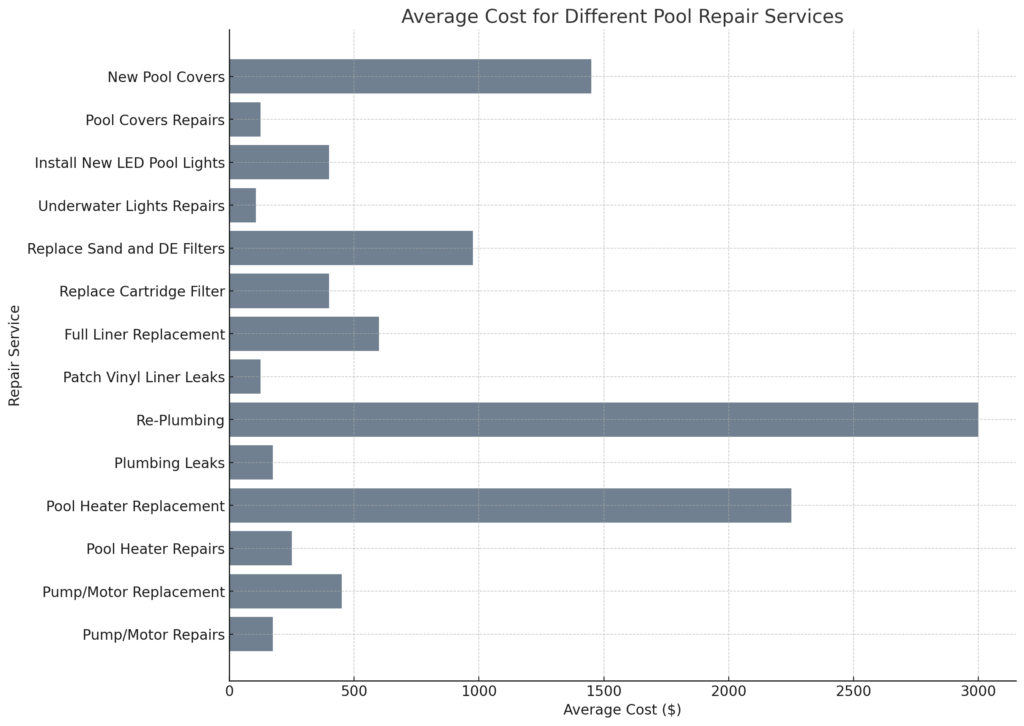
No matter how diligent your maintenance, occasional pool repairs will likely be needed over time. Some common repairs and average costs include:
- The cost of pump/motor repairs falls within the range of $50 to $300, while replacing the pump/motor can range from $250 to $650. To ensure efficiency, it is essential to choose the proper pump size.
- For pool heaters, repair costs typically range from $100 to $400, whereas the cost of replacing a pool heater is higher, ranging from $1,000 to $3,500 with installation.
- Fixing plumbing leaks in a pool averages around $100 to $250, but a complete re-plumbing of the pool may cost between $2,000 and $4,000.
- To patch vinyl liner leaks in a pool, the cost falls in the range of $50 to $200. For a full liner replacement, the cost is higher, ranging from $400 to $800.
- For pool filters, the cost of replacing a cartridge filter with installation ranges from $100 to $700. On the other hand, replacing sand and DE filters comes with a higher cost, ranging from $350 to $1,600.
- When it comes to underwater lights, repair costs typically range from $65 to $150, while installing new LED pool lights can cost between $200 and $600, including installation. Read our how much does it cost to replace a pool light article to know more.
- For pool covers, patching damages can cost between $50 and $200, while purchasing a new manual or automatic cover can range from $400 to $2,500.
Prioritize routine maintenance to maximize the lifespan of equipment and surfaces. When issues arise, hire certified pool pros for the best repairs. Protect your investment for safe, enjoyable swimming.
Equipment Upgrades
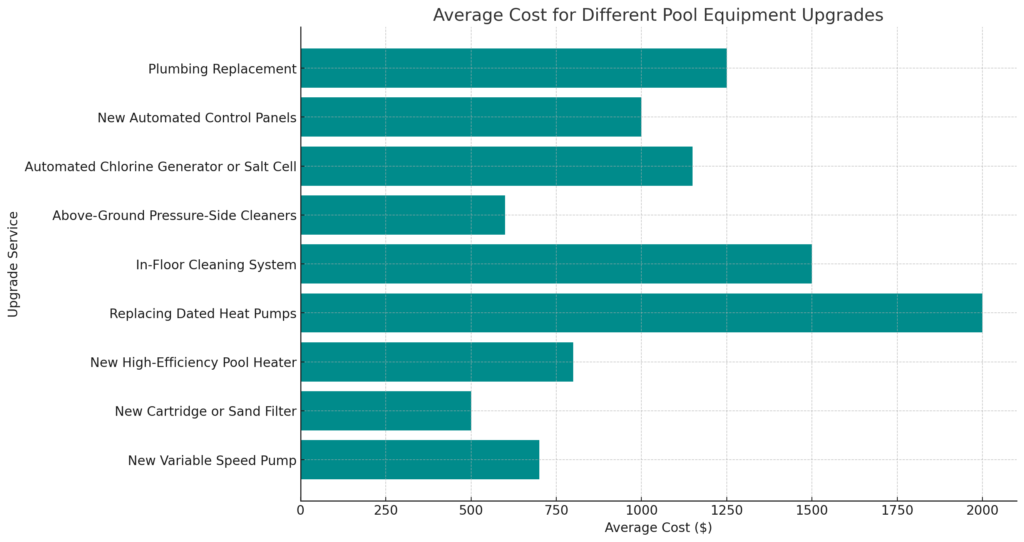
Upgrading aging or inefficient pool equipment can save significantly on long-term maintenance costs.
- Replacing an old inefficient pump with a new energy-efficient variable speed pump can cost between $400 and $1000 for the pump alone. Additional installation costs will apply. Take a look at our how much does it cost to install a pool pump guide to know more.
- Upgrading an aging sand or DE filter to a new cartridge or sand filter can range from $200 to $800 for the filter alone. Installation costs are extra.
- Investing in a new high-efficiency pool heater starts at approximately $800 and goes up, with installation typically adding a few hundred dollars. Replacing dated heat pumps can cost $2000 or more. Take a look at our how much does it cost to install a pool heater guide to know more.
- Adding an in-floor cleaning system to a pool that doesn’t have one starts at around $1500. For above-ground pressure-side cleaners, the cost is in the range of $400 to $800. Read our how much does it cost to install an in floor cleaning system guide to know more.
- Upgrading to a digital automated chlorine generator or salt cell costs between $800 and $1500, plus installation fees. New automated control panels start at around $1000.
- If plumbing needs replacement to accommodate new equipment, the cost can vary from $500 to $2000+ depending on the scope of the project.
The total cost can vary widely based on the specific upgrades being done, as well as local labor costs. But expect to invest at least $2000 to significantly upgrade aging pool equipment, with $5000+ being realistic for more extensive upgrades. Consult a pool company to get quotes for your specific needs.
While equipment upgrades require an initial investment, they cut costs in the long run through energy and chemical savings. Weigh return on investment when considering new pool equipment.
Tips to Reduce Gunite Pool Maintenance Costs
Owning a gunite pool can provide endless hours of fun and relaxation, but it also comes with regular maintenance expenses. As a pool owner, finding ways to reduce maintenance costs without compromising the pool’s cleanliness and functionality is essential.
By implementing a few smart strategies, you can not only save money but also enjoy a pristine pool year-round. In this section, we will explore some effective tips to help you minimize gunite pool maintenance costs while keeping your pool in top-notch condition.
Regular Cleaning and Skimming: Regularly skimming the surface of the pool to remove leaves, bugs, and debris prevents them from sinking to the bottom and creating more work during cleaning. Cleaning the pool walls and floor helps prevent algae and bacteria growth, reducing the need for costly algaecides and additional chemicals. Use a pool vacuum or robotic pool cleaner to efficiently clean the pool bottom and walls.
Proper Chemical Balance: Maintaining the correct chemical balance is crucial for the health of your pool and swimmers. Imbalanced water can lead to algae blooms, cloudy water, and corroded pool equipment. Invest in a reliable pool water testing kit and test the water regularly, at least once a week. Adjust chemical levels as needed to keep them within the recommended ranges.
Use Pool Cover: A pool cover is an essential investment that provides multiple benefits. It prevents debris from falling into the pool, reducing the frequency of cleaning and skimming. It also minimizes water evaporation, which helps maintain the chemical balance and reduces the need to refill the pool frequently. Additionally, a pool cover can slightly extend the swimming season by retaining heat.
Efficient Filtration: Make sure your pool’s filtration system is properly sized for your pool volume. An undersized filter will struggle to keep the water clean, while an oversized one may lead to unnecessary energy consumption. Clean or backwash the filter regularly, as a clogged filter reduces filtration efficiency and can strain the pool pump, resulting in higher energy costs.
Energy-Efficient Pool Pump: Traditional single-speed pool pumps can be energy hogs. Consider upgrading to a variable-speed or variable-flow pool pump, as they can adjust their speed according to the pool’s needs, resulting in substantial energy savings. Variable-speed pumps can also run at lower speeds during off-peak hours, further reducing electricity costs.
Timely Repairs: Address any issues with your pool equipment or pool structure as soon as they arise. Delaying repairs can lead to more extensive damage and higher costs down the line. Regularly inspect your pool equipment, such as the pump, filter, heater, and pool surface, to catch any problems early.
Reduce Pool Heating: Pool heating can be one of the most significant energy expenses for pool owners. Consider using a solar pool heater, which harnesses the sun’s energy to heat the pool water, significantly reducing operating costs. During warm months, turning off the pool heater or lowering its temperature can save on energy bills.
Consistent Monitoring: Regularly check and monitor your pool’s water level, chemical balance, and equipment. This proactive approach allows you to identify and address any potential issues before they escalate into more significant problems.
Pool Landscaping: Plan your pool’s landscaping strategically to minimize the number of trees or plants that shed leaves or debris near the pool. By doing so, you reduce the amount of debris that ends up in the water, lessening the need for frequent cleaning and skimming.
DIY Maintenance: Learning to perform some basic pool maintenance tasks yourself can save you money on service costs. Properly cleaning the pool, backwashing the filter, and checking chemical levels are all tasks that most pool owners can handle with proper guidance.
Group Purchases: If you are part of a community with multiple pool owners, consider joining together to purchase pool chemicals in bulk. Buying in larger quantities often results in lower costs per unit, helping everyone save on pool chemical expenses.
Off-Peak Electricity Usage: If your electricity provider offers time-of-use pricing, run your pool equipment during off-peak hours when electricity rates are lower. This can significantly reduce your pool’s energy-related expenses.
Conclusion
The cost to maintain a gunite pool involves a combination of regular upkeep expenses and occasional repairs. While gunite pools offer durability and versatility, they also demand consistent attention and financial investment to ensure their longevity and safe operation.
Routine maintenance tasks such as cleaning, water balancing, and equipment checks are essential to keep the pool in pristine condition and prevent potential issues from arising. Moreover, budgeting for occasional repairs and unforeseen problems is crucial, as they can significantly impact the overall cost of ownership.
By understanding the various factors that influence maintenance expenses and being proactive in caring for the pool, owners can strike a balance between cost-effectiveness and enjoying the luxury and pleasure of a well-maintained gunite pool for years to come.
Frequently Asked Questions
Yes, there can be hidden expenses associated with maintaining a gunite pool. These may include unexpected repairs, water leak detection and repair costs, higher water and energy bills, and expenses related to algae treatment or chemical imbalances. It is essential for pool owners to budget for these potential hidden costs.
2. How do the maintenance costs of a gunite pool compare to other types of pools?
Generally, the maintenance costs of a gunite pool are slightly higher compared to other types of pools like vinyl or fiberglass pools. This is mainly due to the more intensive cleaning required for the gunite surface, as well as the complexity of the plumbing and filtration systems. However, gunite pools offer greater durability and customization, which can be a worthwhile long-term investment for some pool owners.
3. Can I save money on pool maintenance by doing some tasks myself?
Yes, pool owners can save money on maintenance by performing some tasks themselves. Regular tasks like skimming debris, cleaning the pool walls, maintaining water chemistry (with DIY testing kits), and backwashing the filter can be done by the pool owner. DIY maintenance can reduce the need for frequent professional services and lower overall maintenance costs.
4. How does the size and shape of my gunite pool impact maintenance expenses?
The size and shape of a gunite pool can impact maintenance expenses. Larger pools require more water, chemicals, and time for cleaning, which can increase maintenance costs. Additionally, complex pool shapes with multiple curves or features might require more effort to clean and maintain properly.
5. What water-saving measures can I implement to reduce maintenance costs?
To reduce maintenance costs, you can implement various water-saving measures. Using a pool cover when the pool is not in use can prevent water evaporation, reducing the need to top up the pool frequently. Fixing any leaks promptly can also prevent water wastage, leading to cost savings on both water and chemical usage.
6. How do seasonal changes affect pool maintenance expenses?
Seasonal changes can impact pool maintenance expenses. During the swimming season, warmer months may lead to higher maintenance costs due to increased pool usage, greater water evaporation, and more frequent chemical adjustments. In colder months, additional expenses may be incurred for winterizing the pool, covering it to protect from debris, and adjusting chemicals accordingly during periods of reduced use. Properly preparing the pool for each season can help manage these costs effectively.
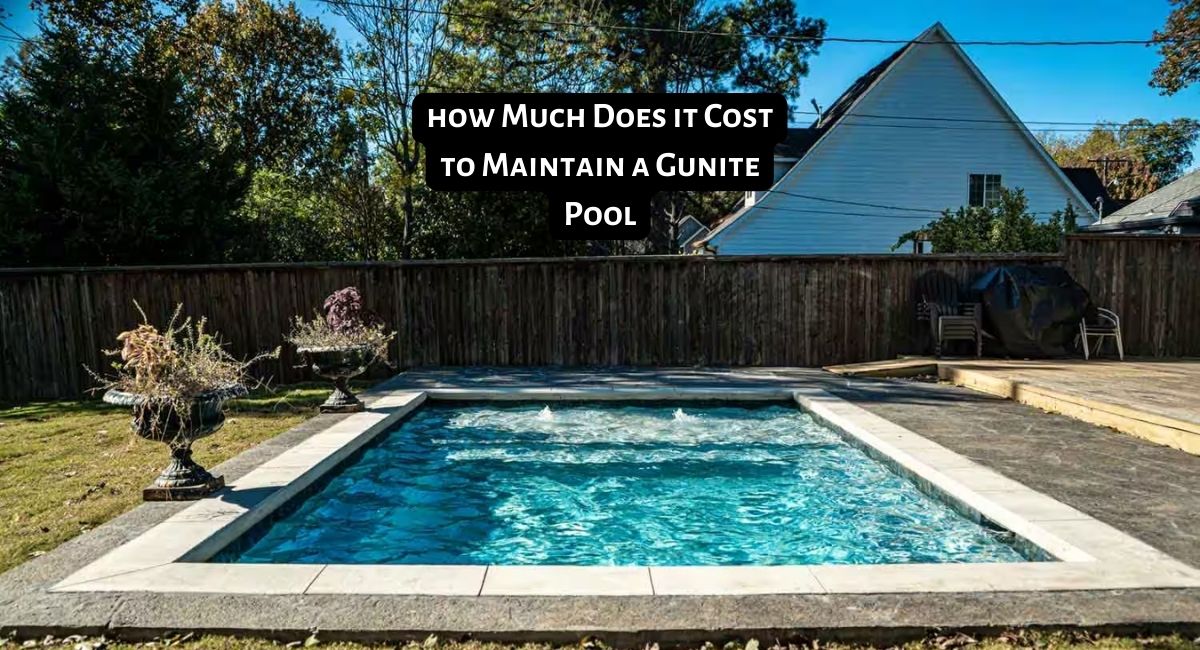
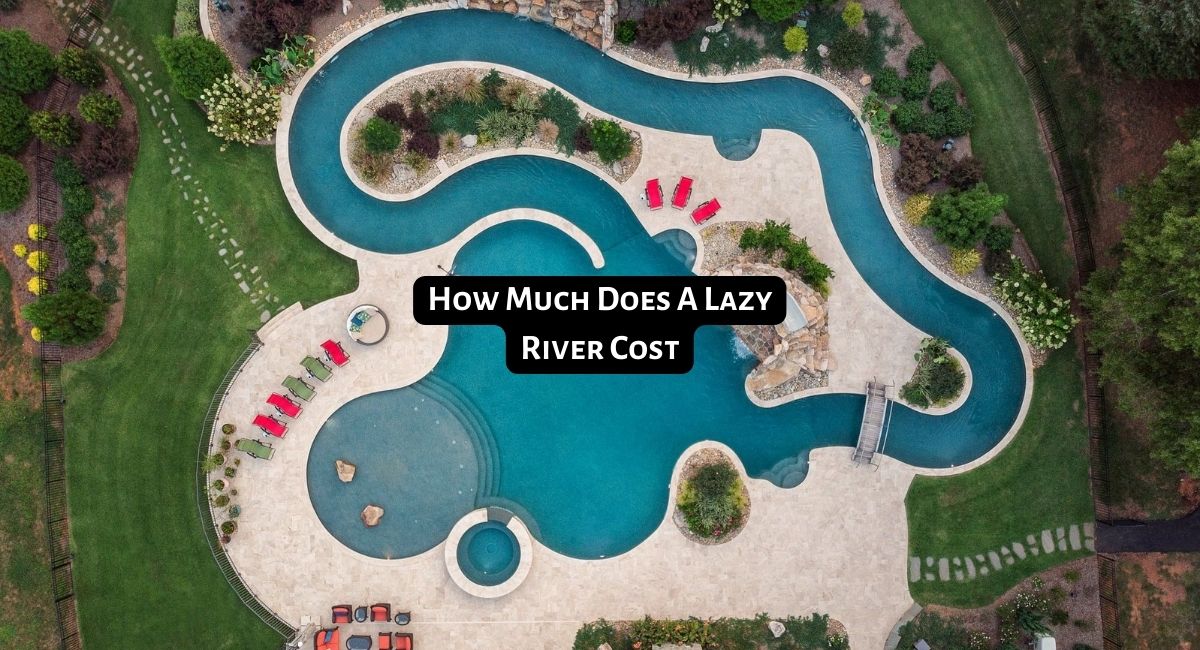
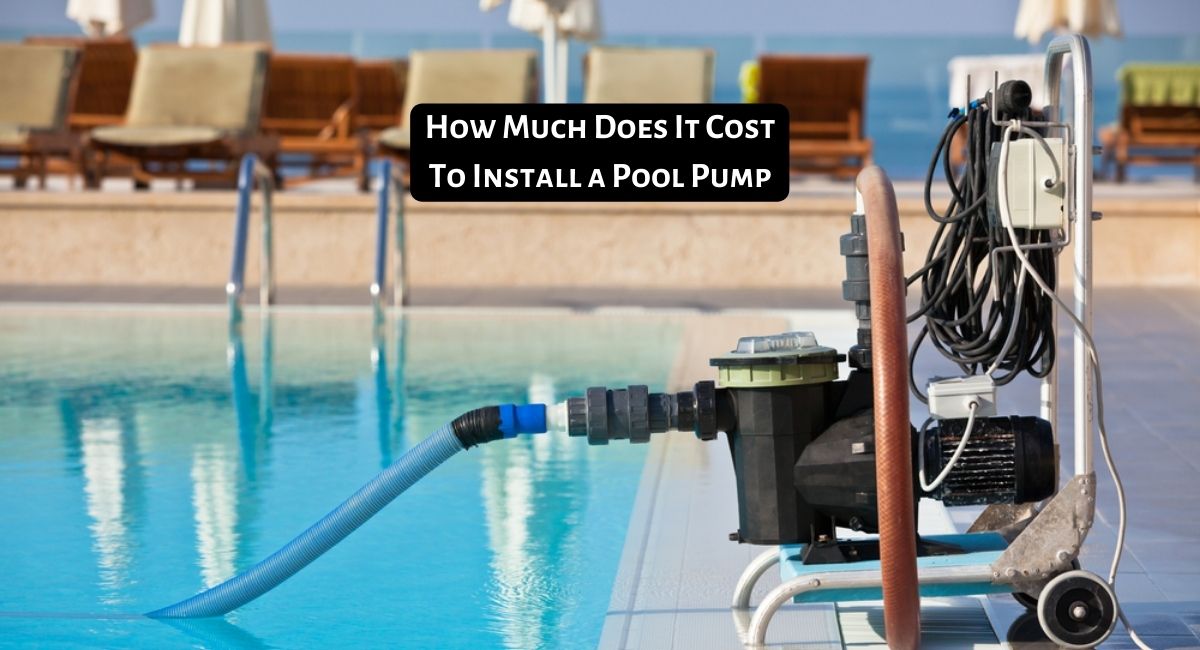
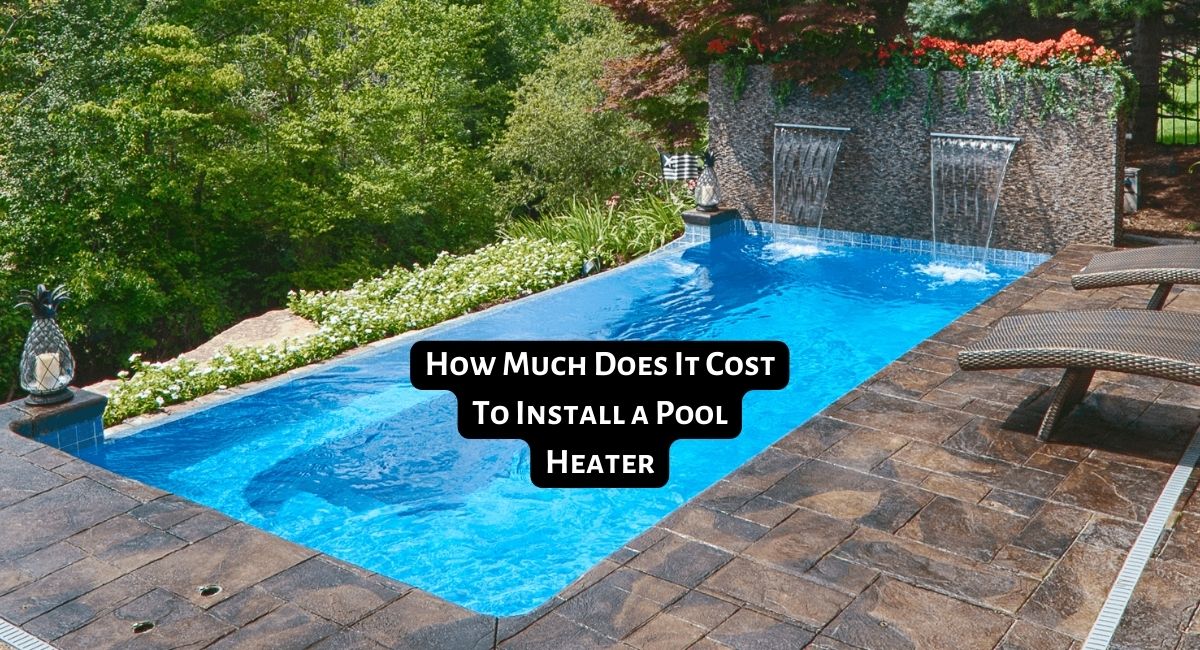
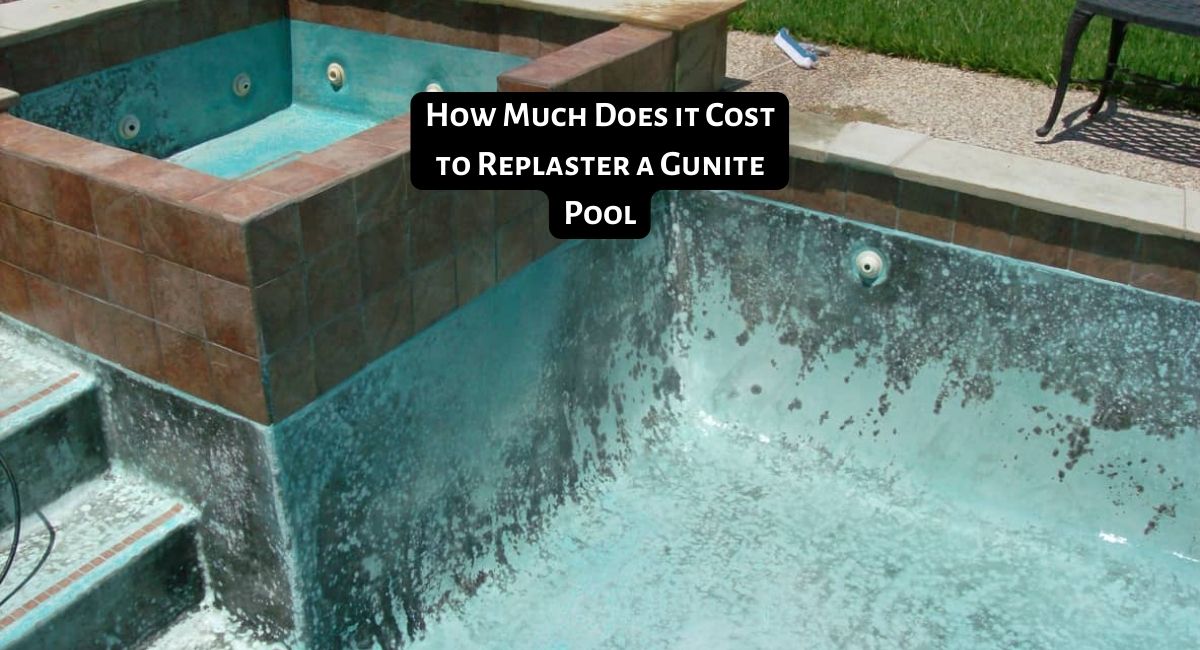
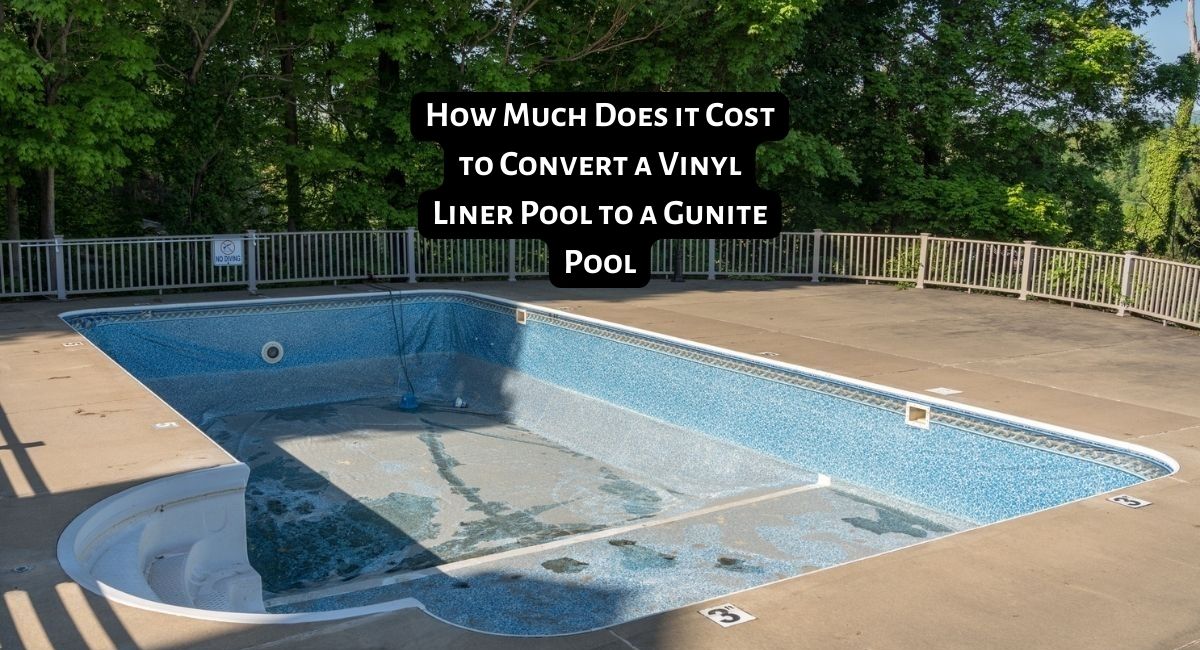

Thanks for helping me understand how installing pool slides that are safe and attractive to the eyes of your children is a good idea. I have a friend who wants to build a pool around his backyard for recreational use. I believe that seeking a pool slide professional that can build and resurface its coating is a good investment.